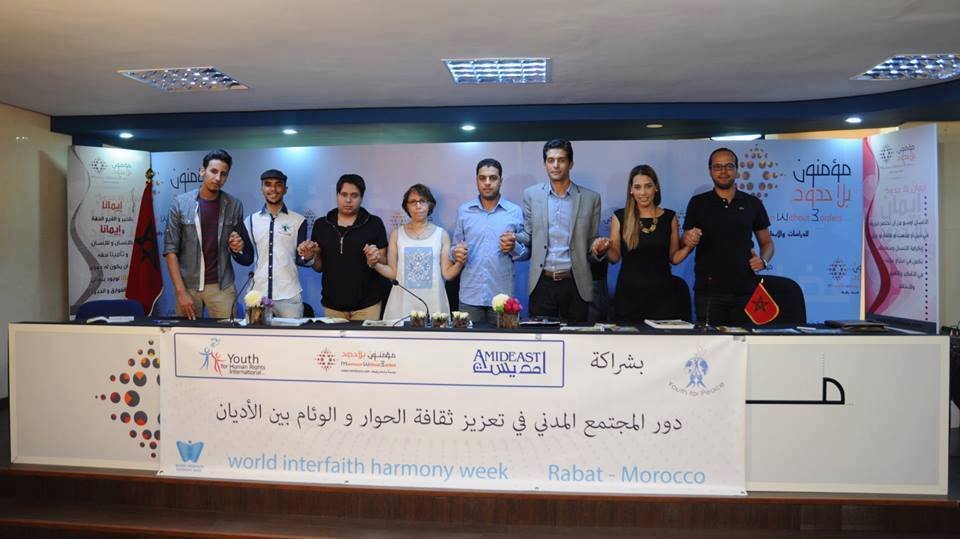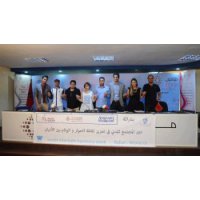|
PRESS RELEASE STANDING TOGETHER FOR PEACE: WORLD INTERFAITH HARMONY WEEK AT YOUTH FOR PEACE Muslim and Jewish Youth leaders come together for panel discussion At the Foundation Mouminoun Without Borders.. Morocco offers a model for Muslim-Jewish friendship RABAT.MOROCCO
As part of the global celebrations around the World Interfaith Harmony Week, this year members of ãMIMOUNAã, which is a Jewish Association, such as Abdo Ladino and Rena Soumia joined the Youth for Peace panel discussion. The panel also included the President of ãYouth for Peaceã Zakaria El Hamel along with Ichrak Touri who is the Director of Public Relationship at AMIDEAST. The meeting was held in Mouminoun Without Borders institution in order to highlight the importance of interfaith harmony.
Every year, in the first week of February, religious leaders all faiths and all over the world organize interreligious activities. Such activities aim at showing their solidarity, strengthening bonds and building bridges within the global interreligious movement. ãWorld Interfaith Harmony Weekã (WIHW), it is an initiative that provides a platform for people to engage in interreligious activities and seeks to spread the message of harmony, tolerance and peace.
Youth for Peace-International, in partnership with Youth for Human rights International, Mimouna Association, Amideast and Mouminoun without Borders. ãÎãÎãÎãÎãÎãÎãÎãÎãÎãÎãÎãÎãÎãÎãÎãÎãÎãÎãÎãÎãÎãÎ.
On the 2nd February, Youth for Peace will have the honor to host Prof. Tariq Ramadan, Cheikh Abdullah Bin Bayyah, at Youth for Peace HQ. These guests will talk about the significance of interreligious dialogue, and its role in solving the problems we face today such as Terrorism is the greatest challenge to world peace. Tariq Ramadan and Cheikh Abdullah Bin Bayyah and other International Speakers will be welcomed to Youth for Peace-International by the Secretary General and the Ambassador of the Kingdom of Jordan to Morocco Youth for Peace Board Members Zakaria El hamel and Honorary Members Mr. Andrûˋ David Azoulay who is Senior Advisor to His Majesty King Mohammed VI of Morocco, President of the Anna Lindh Euro-Mediterranean Foundation for the Dialogue between Cultures, President of the Executive Committee of the Foundation for the Three Cultures and the Three Religions, based in Seville, Spain, a founding member of the C-100 Davos Forum for the Dialogue of Civilizations and religions and Chairman of the International Advisory Board of the Shimon Peres Center for Peace will join Youth for Peace in celebrating World Interfaith Harmony Week in February 2017. World Interfaith Harmony Week
World Interfaith Harmony Week was established by UN resolution in 2010 and is based on the Common Word Initiative, which was created in order to engage Muslim and Christian leaders in dialogue to promote peace. WIHW encourages religious leaders to commit once a year to coordinating IRD activities and unites religions while respecting their uniqueness and independence without compromising any of their own religious tenets. WIHW serves people of all faiths, and those with no faith, to foster peace and harmony in the world. It started at the time of the Prophet Mohammad (peace and blessings be upon him)
The peaceful coexistence of Muslims and Jews began at the time of the Prophet.
Zakaria El hamel notes that Jews welcomed the Prophet when he arrived in Madinah at the time of Hijrah (migration), along with the rest of the city's inhabitants.
But the Prophet had begun the step towards good relations with Jewish and other communities in Madinah even before getting there.
After receiving an invitation to Madinah one of the city's tribes that had accepted Islam, the Prophet signed treaties with the city's Jewish, Christian and polytheist tribes before he arrived there.
These treaties clearly laid out the responsibilities of each of the parties. It was based on these that the Prophet established the Mithaq al Madinah, the constitution of Madinah.
Zakaria El hamel says this was the first constitution of the world and one of the greatest political documents ever prepared by any human being. It is the oldest surviving constitution of any state.
Under this constitution, any Jew who followed the Muslims was entitled to their assistance and the same rights as anyone of them without any injustice or partisanship.
It was said that the Jews are an Ummah (community of believers) alongside the Muslims. The Jews have their religion and the Muslims theirs. In addition, it was noted that each will assist one another against any violation of this covenant.
Morocco was once home to a very large community of 250,000 Jews, the largest in the Arab world. Moreover, they had been living there for the past 2,000 years. In other words, together with Muslim Moroccans, they were an inseparable part of Morocco, its culture, history and civilization and both helped build and shape Morocco to make it what it is today. For centuries, these two communities existed side by side in harmony and friendship. They lived in similar houses, led similar social activities, attended the same schools, worked and had the same jobs and spent great time together as friends. King's Advisor Says, ãMorocco, which enjoys an extraordinary spiritual diversity, is a land of peace, tolerance, and fraternity that respects differences.ã
Mr. Laghmam also mentioned the Palestinian case and said that the conflict there is also political and not religious one. When we look at the history of this region we find that Muslims and Jews lived in peace with each other , there were no problems. However, when politics intervened and therefore some powers wanted to exercise their domination over the others, problems began.
Mr. Laghmam insists on the fact that dialogue and communication should be the basis for any successful relation between religions. Dialogue contributes to the reinforcement of social and religious bonds between different sects and groups. He concluded by saying that we all should be prepared and should work hard in order to establish a culture of respect and tolerance, and to cultivate a culture of human rights and peace.
|



